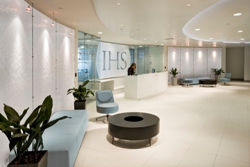Apr 2 2010
IHS, a leading global source of critical information and insight, today announced that it has received Leadership in Energy and Environmental Design (LEED) Gold Certification for Commercial Interiors from the Canada Green Building Council for the company’s new Calgary office space. The LEED Green Building Rating System™ encourages and accelerates global adoption of sustainable green building and development practices through the creation and implementation of universally understood and accepted operating standards and performance criteria.
 IHS Calgary Office
IHS Calgary Office
“Implementing key improvements in the operating practices at our new Calgary facility is just one way IHS is committed to creating an environmentally healthy workplace that supports our business operations as well as our colleagues’ and visitors’ well being,” said IHS Vice President, Global Product Portfolio Ganesh Murdeshwar. “We are very proud to be recognized by the Canada Green Building Council for our efforts in this regard.”
LEED Canada for Commercial Interiors is the green benchmark for the tenant improvement market. It is the recognized system for certifying high-performance green interiors that are healthy, productive places to work; are less costly to operate and maintain; and have a reduced environmental footprint. Projects under consideration for certification are evaluated on six categories: sustainable site development, water efficiency, energy efficiency, materials selection, indoor environmental quality and innovation and design. IHS made many office improvements, and worked with the building owners to make several building-level changes to meet these metrics, including:
- Upgraded water fixtures, reducing potable water usage by more than 30 percent;
- Energy efficient appliances installed throughout, and IT equipment upgraded wherever necessary to meet energy efficiency standards;
- Four-year commitment to use 50 percent renewable wind energy;
- Usage of locally sourced materials, requiring less transport and reducing associated carbon emissions;
- Integration of recycled materials wherever possible, as well as materials free of heavy metals, asbestos, formaldehyde and other toxic substances;
- Improved building ventilation system and usage of low volatile organic compound (VOC) adhesives, primers and sealants;
- Careful consideration of office layout and furniture selection to maximize natural light availability in colleague workspaces;
- Site selection with excellent access to mass transit;
- Secure bike rack storage and changing rooms to encourage colleagues to bike to work and reduce emissions; and
- Site selection that implemented “brown site” redevelopment (improving existing space rather than disturbing new ground).
Source: http://www.ihs.com